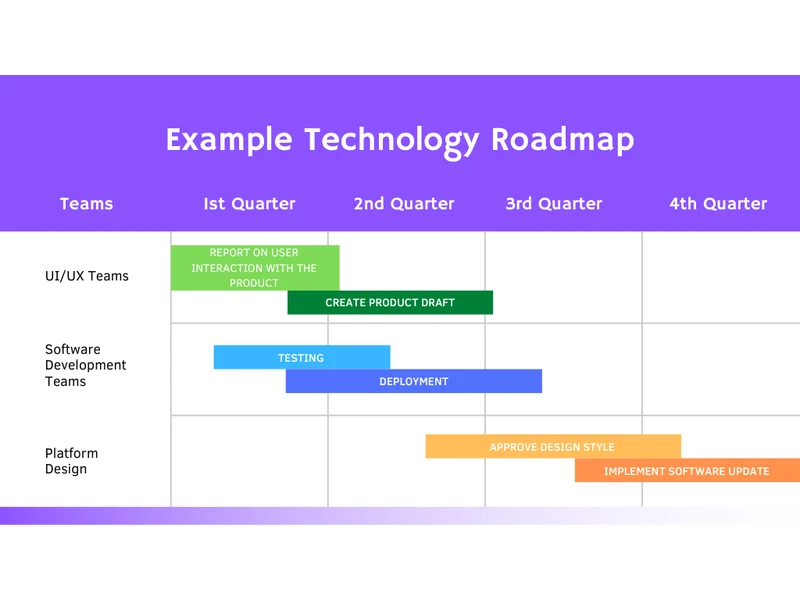In 1999, Amazon encountered an issue with onboarding and serving new retail customers, as they needed to rewrite lots of code to onboard new customers and maintain its existing ones. To do that, they hired a web development team (which eventually created Amazon Web Services (AWS) in 2006) and implemented a technology roadmap — a tool that helps companies understand their present capacity and assess the limits of their IT infrastructure.
In this post, we’ll be taking a look at technology roadmaps, how, and why you want to have one for your company.
What is a Technology Roadmap?
A technology roadmap offers your company a bird's eye view of your technology needs, enabling you to achieve your short and long-term commercial goals. It's a governing document that reinforces your business strategy through your technology to secure your business's direction.
In other words, it explains your objectives and the process to reach those objectives while working with your technology stack.
The engineering and operations teams usually write the tech roadmap. However, these teams should involve the product manager, product owner, development representative, UX designers, DevOps, and executive stakeholders. A research paper claims NASA, Boeing, Lockheed, and the USAF, have been using this strategy since the 1960s.
Why is a Technology Roadmap Essential?
Companies use the technology roadmap to provide foresight into business needs. A technology roadmap also helps you act in the business's best interest.
There are many other reasons why you need a roadmap. Some of the standout ones include:
- To create helpful discussion around the technology that needs to be prioritized, financed, and upgraded, and how the upgrade could help with overall business success.
- To help the IT department anticipate their tech needs and be able to meet them either through outsourcing or in-house work.
- To understand your technological capacity and get the most out of it.
- To avoid overspending and redundancy while budgeting for IT expenses.
- To help carry organization and IT executives along on a project.
- To create a clear objective of current projects enabling those in charge to know what promise they'd be delivering on.
Now that we've got the 'why' out of the way, how can you develop a roadmap that guides the business plan and contributes to long-term strategies?
How Do You Make a Technology Roadmap?

According to Roadmunk, the universal application of a tech roadmap is to define and document the internal IT system of an organization. It's cliche to say you should visualize your goals, but that’s the purpose of a visual roadmap. And although it's an evolving document, there’s still a proper way to approach it.
The Objective of the Roadmap
The first thing you should do before creating your roadmap is to identify the purpose you want it to achieve. This helps to know the end goal, and the objective could be to:
- Track product features.
- Find ways to do more with technology.
- Uncover ways to improve existing infrastructure in a phase of your product.
- Find ways to improve the integration of Tool A with Tool B.
- Help your customers enjoy more product features from without integrating complex software.
Identifying the objectives makes it easier to figure out the themes the roadmap will be based on — development, application, or internal IT systems. Executing any of these means that your activity will overlap with another person’s office, depending on how profound the technology roadmap would be.
For example, your plans may affect the product, so you need to speak to a product manager, business or dev team. If it affects how your marketing team communicates your product to potential customers, you’d also need to speak to them about timelines so they’d advise on the best time to integrate new features.
Now that you understand this, how can you demonstrate the initiatives that your technology roadmap will support and how it connects to the business strategy? You've got to meet with the stakeholders.
Speak with Key Stakeholders
Speaking with stakeholders from marketing, development, product, or any other team lets you input their concerns on how an adjustment in the technology will affect their work. It also lets you strategize how your proposed technology or IT strategy will make their work efficient.
Aside from this, they're the eyes that’ll scrutinize your technology roadmap and should be involved in the process from the start. This will eventually reduce the back-and-forth and revising the ideas proposed to the organization.
Another important reason you should speak to them is to take insights from what they consider the tech challenges with the product or IT infrastructure. They could even propose innovative ways to deliver excellent services with newer or existing resources.
Finally, speaking to the key stakeholders will help you get a better grasp on the order of priority, time, or cost.
Identify What to Prioritize
Now that you’ve acquired essential information, you need to figure out what information or strategy to be prioritized by the organization for the short and long term. You can start by prioritizing the most vulnerable part of your technology stack, which could be your cybersecurity environment, migration to the cloud, any hardware, or database system that needs an update.
You can also consider what, from a tech point of view, is holding back the success of your product. You may need to understand the latter by speaking to the sales team that is often in charge of taking customer complaints about the product.
Whatever it is, putting out your biggest fears should be your priority to maximize your resources and IT budget in activities that will convert into business success.
You can also design the tech roadmap in order of cost. The success of your roadmap depends on the organization’s budget. Running or auditing your IT architecture or infrastructure is expensive and could be very challenging to execute at once.
You should identify the technologies that drain your resources and develop ways to replace them to make your operations more cost-efficient.
To learn more about technology cost and how to calculate it, you can read this post.
You’re likely to help your organization achieve revenue goals when you find a middle ground in reducing costs without compromising business efficiency.
Design a Structure to Build the Technology Roadmap in
Visualizing or converting your technology roadmap into a presentation (or, better yet, an image with everything you need) is the final phase of building a technology roadmap. There are two usual ways to design your roadmap.
You can choose a style that indicates the timeline and the objective. That is, it has a quarterly or monthly tag and the objective to be achieved at the end of each period. Note that each timeline and project should be designed based on a feasible plan.
You can’t expect the app development team to complete an integration that could take six months within two. Here’s a visual technology roadmap example that you can use for inspiration:

Another style is one where there are no timelines. Instead, you track progress based on what has been done and the task that should come after it.
In the end, it all depends on your goals and what kind of change you want in your IT infrastructure.
FAQs:
Q1: What is included in a technology roadmap?
Your tech roadmap discusses the “why,” “what,” and “when” of significant tech changes in your product, services, or the company. Therefore, it must include the following:
- The goals of the project, which could be cutting IT costs or improving automation.
- Initiatives of the project, that is, the themes that the tech roadmap will cover to achieve those goals.
- The features, case studies, or tasks that spurred the need for a tech roadmap. This helps ensure that your idea can help solve actual business problems.
- Release, schedules, and versions of the product or IT change. This helps you tie down the timeline to achieve the end goals.
- Timeline, including the milestones and what each achievement would look like when completed.
Q2: Why is a technology roadmap important?
A technology roadmap is one of the classic ways to know which part of the business's IT infrastructure or product development needs improvement.
This could be the need to enhance automation and increase app efficiency in the next update, create valuable discussion around the organization's technology infrastructure, and craft ideas to make the technology better.
A technology roadmap is also essential to understand what needs improvement in an organization and the strategic plans to go about it.
Q3: What is a technology release roadmap?
A technology release roadmap is created to outline the recent improvements, features, and bug fixtures to integrate into the next product update cycle.
It encompasses short and long-term sprints (that is, time-boxed periods to complete a task) to organize the plan based on easy-to-complex or hard-to-easy.
